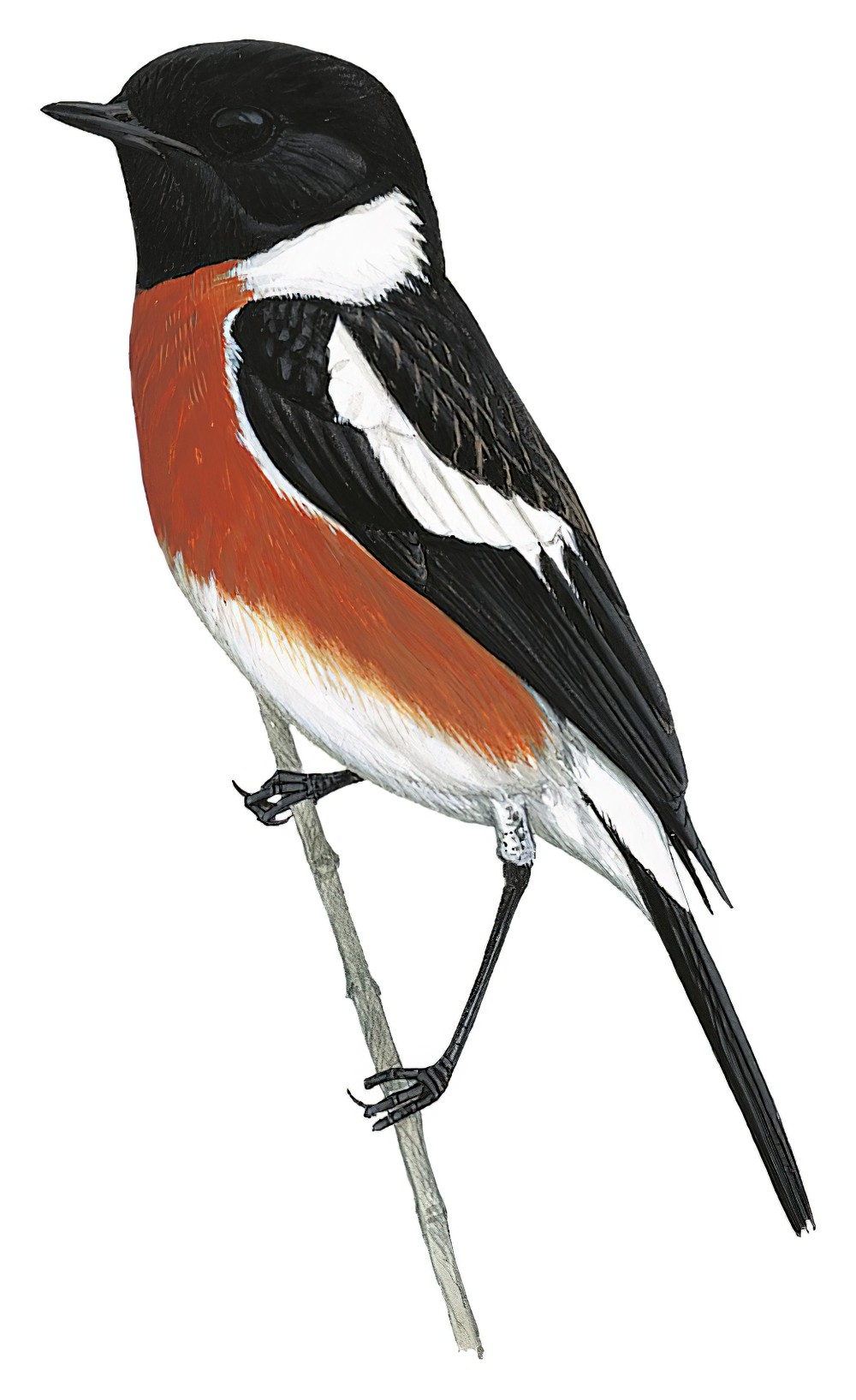African Stonechat / Saxicola torquatus

African Stonechat
SCI Name:
Protonym: [Motacilla] torquata Syst.Nat.ed.12 ed.12 p.328
Taxonomy: Passeriformes / Muscicapidae / Saxicola
Taxonomy Code: afrsto1
Type Locality: Cape of Good Hope.
Author: Linnaeus
Publish Year: 1766
IUCN Status:
DEFINITIONS
SAXICOLA
(Muscicapidae; Ϯ Common Stonechat S. torquatus rubicola) L. saxum, saxi stone; -cola dweller < colere to inhabit; "Gattung. Steinschmätzer. Saxicola. ... Sie machen den schicklichsten Uebergang zu den Fliegenfängern nach Gestalt und Lebensart; nisten auf der Erde oder in Löchern, und fressen blos Insekten, und zwar Käferarten und Fliegen. *1. Großer Steinschmätzer (S. Oenanthe). ... *2. Braunkehliger Steinschmätzer (S. Rubetra). ... Ϯ3. Schwarzkehliger Steinschmätzer (S. Rubicola)" (Bechstein 1802); “Bechstein’s genus Saxicola ... contains three species only: œnanthe (Wheatear), rubetra (Whinchat), and rubicola (Stonechat). No type was originally designated, but Swainson (Zoologist Journ. iii. 1827, p. 172) subsequently fixed as the type Motacilla rubicola. Gray in 1841 and Seebohm (Cat. Bds. B. M. v. 1881, p. 362) made “œnanthe” the type; there can be no doubt, however, that Swainson’s designation must stand, and another name be found for the Wheatears” (BOU 1915); "Saxicola Bechstein, 1803, Orn. Taschenb., (1802), p. 216. Type, by subsequent designation (Swainson, 1827, Zool. Journ., 3, p. 172), Motacilla rubicola Linnaeus." (Ripley in Peters 1964, X, 104). Some workers believe that this form could be split into as many as seven species (i.e. S. torquatus, S. rubicola, S. maurus, S. przewalskii, S. stejnegeri, S. albofasciatus, S. sibilla).
Var. Laxicola.
Synon. Curruca, Fruticicola, Pratincola, Rhodophila, Rubetra.
● (syn. Oenanthe Ϯ Northern Wheatear O. oenanthe) Formerly this name was much used for the wheatears and similar chat-like species (see above).
saxicola
L. saxum, saxi stone, rock; -cola dweller < colere to inhabit.
torquatus
L. torquatus collared < torques collar, necklace < torquere to twist.
● ex “Tangara de la Guyane” of d’Aubenton 1765-1781, pl. 742 (syn. Arremon taciturnus).
● ex “Pic à cravate noire” of d’Aubenton 1765-1781, pl. 863 (Celeus).
● ex “Pluvier à collier” of Brisson 1760 (syn. Charadrius hiaticula).
● ex “Ring Plover” of Leach 1816 (syn. Charadrius hiaticula).
● ex “Pluvier à collier de S. Domingue” of Brisson 1760 (syn. Charadrius vociferus ternominatus).
● ex “Clouded Shrike” of Latham 1787 (Cracticus).
● ex “Barbu à Plastron Noir” of Levaillant 1806 (Lybius).
● ex “Ring Pheasant” of Latham 1783 (subsp. Phasianus colchicus).
● ex “Perruche à collier” of d’Aubenton 1765-1781, pl. 551, and “Perruche à collier couleur de rose” of de Buffon 1770-1783 (syn. Psittacula krameri).
● ex “Cochitenacatl” of Hernandez 1651, “Toucan à collier du Méxique” of Brisson 1760, “Cochicat” of de Buffon 1770-1783, and “Collared Toucan” of Latham 1781 (Pteroglossus).
● ex “Gobe-mouche à collier du Cap de Bonne Espérance” of Brisson 1760 (Saxicola).
● "95. TURDUS. ... torquatus. 13. T. nigricans, torque albo, rostro flavescente. Faun. svec. 185. Merula torquata. Gesn. av. 607. Aldr. orn. l. 16. t. 11. Will. orn. 143. t. 37. Raj. av. 65. n. 2. Alb. av. I. p. 37. t. 39. Frisch. av. 30. f. 1. 2. Habitat in Europa." (Linnaeus 1758) (Turdus).
● ex “Perruche à collier” of de Buffon 1770-1783, “Petite Perruche à collier de l’isle de Luçon” of Sonnerat 1776, and “Collared Parrakeet” of Latham 1781 (unident.).
SUBSPECIES
African Stonechat (African)
SCI Name: Saxicola torquatus [torquatus Group]
SAXICOLA
(Muscicapidae; Ϯ Common Stonechat S. torquatus rubicola) L. saxum, saxi stone; -cola dweller < colere to inhabit; "Gattung. Steinschmätzer. Saxicola. ... Sie machen den schicklichsten Uebergang zu den Fliegenfängern nach Gestalt und Lebensart; nisten auf der Erde oder in Löchern, und fressen blos Insekten, und zwar Käferarten und Fliegen. *1. Großer Steinschmätzer (S. Oenanthe). ... *2. Braunkehliger Steinschmätzer (S. Rubetra). ... Ϯ3. Schwarzkehliger Steinschmätzer (S. Rubicola)" (Bechstein 1802); “Bechstein’s genus Saxicola ... contains three species only: œnanthe (Wheatear), rubetra (Whinchat), and rubicola (Stonechat). No type was originally designated, but Swainson (Zoologist Journ. iii. 1827, p. 172) subsequently fixed as the type Motacilla rubicola. Gray in 1841 and Seebohm (Cat. Bds. B. M. v. 1881, p. 362) made “œnanthe” the type; there can be no doubt, however, that Swainson’s designation must stand, and another name be found for the Wheatears” (BOU 1915); "Saxicola Bechstein, 1803, Orn. Taschenb., (1802), p. 216. Type, by subsequent designation (Swainson, 1827, Zool. Journ., 3, p. 172), Motacilla rubicola Linnaeus." (Ripley in Peters 1964, X, 104). Some workers believe that this form could be split into as many as seven species (i.e. S. torquatus, S. rubicola, S. maurus, S. przewalskii, S. stejnegeri, S. albofasciatus, S. sibilla).
Var. Laxicola.
Synon. Curruca, Fruticicola, Pratincola, Rhodophila, Rubetra.
● (syn. Oenanthe Ϯ Northern Wheatear O. oenanthe) Formerly this name was much used for the wheatears and similar chat-like species (see above).
African Stonechat (Ethiopian)
SCI Name: Saxicola torquatus albofasciatus
albofasciata / albofasciatus
L. albus white; Late L. fasciatus banded < L. fascia band.
African Stonechat (Madagascar)
SCI Name: Saxicola torquatus sibilla
sibilla
L. sibilare to whistle < sibilus whistling (cf. Sibylla, prophetess and priestess of Apollo).
● ex “Traquet de Madagascar” of Brisson 1760 (subsp. Saxicola torquatus).
UPPERCASE: current genus
Uppercase first letter: generic synonym
● and ● See: generic homonyms
lowercase: species and subspecies
●: early names, variants, mispellings
‡: extinct
†: type species
Gr.: ancient Greek
L.: Latin
<: derived from
syn: synonym of
/: separates historical and modern geographic names
ex: based on
TL: type locality
OD: original diagnosis (genus) or original description (species)












